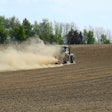
A team of scientists from the U.S. Department of Agriculture (USDA) Agricultural Research Service (ARS) and Colorado State University (CSU) has identified a wild millet species with remarkable drought resilience, potentially offering a breakthrough in crop protection against water scarcity.
The research, led by ARS plant physiologist Sean Gleason, utilized innovative X-ray technology to observe water movement within plants during drought stress. This method allowed researchers to visualize the formation of gas bubbles, or embolisms, in plant tissues that impede water transport.
"We call this plant resurrection millet because if the plant is watered even after nearly 100% of the tissue has been embolized, the plant is able to refill these embolisms and recover," Gleason said.
This discovery challenges long-standing assumptions about plant hydraulic recovery and could have significant implications for crop resilience in water-limited environments.
Troy Ocheltree, a collaborator from CSU's Department of Forest and Rangeland Stewardship, highlighted the potential impact on agriculture and grasslands. "The results suggest that even if plants become severely stressed, they may be able to recover in the same year of the drought and begin growing again," he said.
Drought accounts for approximately 25% of U.S. crop production losses. The ability to transfer this millet's resiliency to major crops like wheat, corn, and rice could significantly enhance food security and reduce economic losses in agriculture.
The research team is now exploring ways to leverage this new understanding of drought resistance to develop more resilient crop varieties, potentially revolutionizing agricultural practices in drought-prone regions.
This study underscores the importance of continued investment in agricultural research, with the USDA noting that each dollar invested typically yields $20 in economic impact.

















